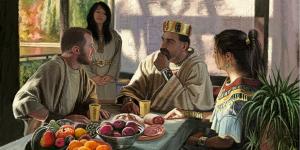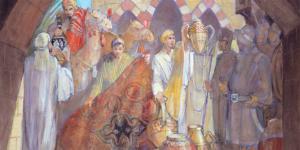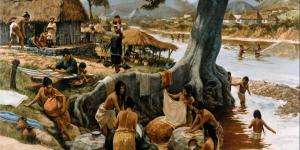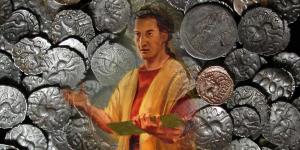You are here
Book of Mormon Central is in the process of migrating to our new Scripture Central website.
We ask for your patience during this transition. Over the coming weeks, all pages of bookofmormoncentral.org will be redirected to their corresponding page on scripturecentral.org, resulting in minimal disruption.
Gospel Doctrine Lesson #23: More Than One Witness

Scripture Block
Alma 8-12
To increase class members’ understanding of the plan of redemption and the power of having more than one witness to testify of gospel truths.
Lesson Manual
KnoWhys

Why Did Alma Talk about Melchizedek?
Alma 13:14
Multimedia
"Chart 8-110: King Mosiah's Monetary System" by John W. Welch and Greg Welch in Charting the Book of Mormon.
King Mosiah's system of weights and measures established equivalencies between amounts of silver, gold, and grains. This chart compares the precious metals with their grain equivalents, as described in Alma 11. These measurements for the most part increase exponentially, much like the ancient Egyptian system of measurement (see chart 113). In King Mosiah's system, the limnah or onti, worth "the value of . . . all" measurements (Alma 11:10), was worth the sum of the gold senine, seon, and shum or the silver senum, amnor, and ezrom.
Video: Discussions on the Book of Mormon: Alma 8-12. Available at BYUtv.org.
Professors from the BYU Department of Ancient Scripture discuss Alma's continuing efforts to reclaim the apostate Nephite nation.
Articles
Alma 8
“Notes and Communications—The Nephite and Jewish Practice of Blessing God after Eating One’s Fill,” by Angela M. Crowell and John A. Tvedtnes Journal of Book of Mormon Studies 6, no. 2 (1997): 251–254.
In Alma 8, Alma eats a meal with Amulek and then after utters a prayer to thank God. While many Christians today are used to offering prayers before meals are eaten, Alma's behavior matches the Jewish practice of offering prayer in thanksgiving after a meal has been eaten.
"When Less is More: The Reticent Narrator in the Story of Alma and Amulek" by Charles Swift Religious Educator 13, no. 1 (2012).
The Book of Mormon has various narrators, sometimes Nephi, sometimes Mormon, and to some extent, even Joseph Smith. These narrators, while trying to convey important information about the story, often leaves many things unsaid. Charles Swift takes the story of Alma and Amulek to expound upon how this silence from the narrator actually increases the poignancy of the story and brings further insight into the narrative.
"Conflicting Orders: Alma and Amulek in Ammonihah" by Thomas R. Valletta in The Temple in Time and Eternity.
Alma 8-14 discuss the establishment of the church, and Nehor's attempt to establish his own theology. This paper focuses on the conflict between the holy order of the Son of God and the order of Nehor. The former was patterned after the Savior’s life and was rooted in keeping sacred covenants centered in the temple as a symbol of eternity. The latter was patterned after an ambitious murderer and rooted in prideful competition in which individuals were resolute on attaining money as a means of power and riches. Important comparisons and contrasts between these two opposing orders emerge from these chapters; their sources of authority and power, heroes, centers and rituals of worship, doctrines and standards of behavior, and aspirations and purposes are a few of the most obvious.
"Book of Mormon Names Attested in Ancient Hebrew Inscriptions" by John A. Tvedtnes, John Gee, and Matthew Roper Journal of Book of Mormon Studies 9, no. 1 (2000).
This article explores several Book of Mormon proper names that are attested from Hebrew inscriptions. Names included are Sariah, Alma, Abish, Aha, Ammonihah, Chemish, Hagoth, Himni, Isabel, Jarom, Josh, Luram, Mathoni, Mathonihah, Muloki, and Sam—none of which appear in English Bibles.
"Amulek" by James Fullmer, original painting.
A man of no small reputation in Ammonihah, but he rebeled against God. After being visited by an angel, he helped Alma the Younger preach to the people of Ammonihah and suffered the loss of his family and possessions as a result. He became a powerful missionary, however, and was instrumental in the conversion of Zeezrom.
Alma 9
"Prospering in the Land of Promise" by Steven L. Olsen FARMS Review 22, no. 1 (2010).
Nephi and Mormon both treat the covenant of the promised land, expounding on characteristics of prospering in the land: obeying God’s law, practicing domesticated economies, preserving sacred records, bearing and raising children, securing adequate defense, constructively using natural materials, worshipping at temples, requiring industriousness, and providing righteous leadership.
"The Covenant of the Promised Land" by Steven L. Olsen FARMS Review 22, no. 2 (2010).
The symbolism of land and its covenantal associations are viewed as guiding structural elements in the Book of Mormon narrative. Involving “existential space” more than “geometric space,” the concept of land is central to an understanding of the book as a sacred, covenant-based record.
Alma 10
"'Stretch Forth Thy Hand and Prophesy': Hand Gestures in the Book of Mormon" by David A. Calabro Journal of Book of Mormon Studies 21, no. 1 (2012).
This article discusses the meaning and significance of four specific gestures referred to in the Book of Mormon: stretching forth one’s hand(s), stretching forth the hand to exert divine power, extending the arm(s) in mercy, and clapping the hands to express joys. In Alma 10, Alma stretches forth his hand to prophesy and cry repentance unto the people of Ammonihah.
"The Trial of Alma and Amulek" by John W. Welch in Legal Cases in the Book of Mormon.
In this chapter of Legal Cases in the Book of Mormon, John Welch looks at the legal implications of Alma and Amulek's preaching in Ammonihah. As followers of Nehor, the people of Ammonihah rejected Alma and Amulek and found legal grounds to condemn their preaching under the law. However, despite the people's accusations, Alma and Amulek likewise found ways to accuse their persecutors of not complying with the Law of Moses.
"A Note on Family Structure in Mosiah 2:5" by Stephen D. Ricks Interpreter: A Journal of Mormon Scripture 6 (2013)
Stephen Ricks points out a distinction in terminology when referring to someone's family. While one Hebrew words denotes a nuclear family, one that is more commonly used refers to the entirety of one's extended family. When learning about the family of Amulek, it is useful to remember that his "family" or his "house" may have included multiple generations and more distant relatives.
Alma 11
"A Nickname and a Slam Dunk: Notes on the Book of Mormon Names Zeezrom and Jershon" by Stephen D. Ricks Interpreter: A Journal of Mormon Scripture 8 (2014).
Stephen Ricks describes the proposed etymology of the name Zeezrom and suggests that the name may be used as more of a nickname than an actual given name. By breaking down the Hebrew, one can determine that Zeezrom may mean "he of the Ezrom" or rather "he of the silver/money".
"Weighing and Measuring in the Worlds of the Book of Mormon" by John W. Welch Journal of Book of Mormon Studies 8, no. 2 (1999).
This article addresses the seemingly misplaced discussion of weights and measures in the middle of Alma 11 in the Book of Mormon. Although the interruption initially seems strange, John Welch offers new insights to explain its purpose in the Book of Mormon. For instance, knowledge of the Nephite monetary system supplements a reader’s comprehension of the bribery and corruption that occurred in that society. Evidence of this monetary system also shows a link between Near Eastern civilizations and Book of Mormon civilizations, thus providing further evidence for the divinity of Joseph Smith’s work.
"What's in a Name? Book of Mormon Language, Names, and [Metonymic] Naming" by Gordon C. Thomasson Journal of Book of Mormon Studies 3, no. 1 (1994).
This articles leads a discussion of the general function of names in kinship; secret names; and names, ritual, and rites of passage precedes a Latter-day Saint perspective. Names and metonymy are used symbolically, such as in the example of Zeezrom in Alma 11.
"Latest Findings in the Book of Mormon Critical Text Project" by Royal Skousen Insights 26 (2006).
Royal Skousen provides new readings of the Book of Mormon, including a few variants in Alma 11. Royal Skousen proposes a change in the word "ezrom," "shiblum," and "strip". in Alma 11.
"A Mesoamerican System of Weights and Measures?" by John W. Welch Journal of Book of Mormon Studies 8, no. 2 (1999).
Ancient Mesoamericans used some systems of weights and measures; items in the market, though, were usually sold by volume. The Mesoamerican weights and measures may coincide with the weights and measures described in Alma 11 of the Book of Mormon, but more research is necessary in order to make conclusive claims.
"The Laws of Eshnunna and Nephite Economics" by John W. Welch in Pressing Forward with the Book of Mormon.
In enacting his law, King Mosiah “did not reckon after the manner of the Jews who were at Jerusalem” (Alma 11:4), but he still utilized a system that drew on elements known in the ancient Near East. Such similarities between the Laws of Eshnunna (discovered and translated in the mid– twentieth century) and Mosiah’s economic system show yet another way in which the Book of Mormon presents a truly complex civilization with roots in ancient society
"Chart 8-110: King Mosiah's Monetary System" by John W. Welch and Greg Welch in Charting the Book of Mormon.
King Mosiah's system of weights and measures established equivalencies between amounts of silver, gold, and grains. This chart compares the precious metals with their grain equivalents, as described in Alma 11. These measurements for the most part increase exponentially, much like the ancient Egyptian system of measurement (see chart 113). In King Mosiah's system, the limnah or onti, worth "the value of . . . all" measurements (Alma 11:10), was worth the sum of the gold senine, seon, and shum or the silver senum, amnor, and ezrom.
Alma 12
"The Temple in the Book of Mormon: The Temples at the Cities of Nephi, Zarahemla, and Bountiful" by John W. Welch in Temples of the Ancient World.
This article attempts to examine every reference to temples in the Book of Mormon, in order to glean subtle information from those verses and their contexts. In doing this, I have tried especially to understand words and motifs as a Nephite might have understood them, staying alert to the possibility that temple allusions may be found even in simple words and phrases. John W. Welch labels Alma 12-13 as a "temple text", or a text that teaches on and refers to various aspects of the ancient temple ceremonies.
"Alma 12: The Universal Power of Apostasy" by LeGrand L. Baker and Stephen D. Ricks in Who Shall Ascend Into the Hill of the Lord?: The Psalms in Israel's Temple Worship in the Old Testament and the Book of Mormon.
This chapter discusses the narrative of apostasy we find in Alma 12, and compares this to an archetypal pattern of apostasy that can be exhibited time and time again in scripture and in modern day lives.
"Alma 12:3: But Thou Hast Lied Unto God" by LeGrand L. Baker and Stephen D. Ricks in Who Shall Ascend Into the Hill of the Lord?: The Psalms in Israel's Temple Worship in the Old Testament and the Book of Mormon.
This article is a short piece addressing how lying unto God is a form of breaking sacred covenants.
"Alma 12:5-6, The Power of an Embrace" by LeGrand L. Baker and Stephen D. Ricks in Who Shall Ascend Into the Hill of the Lord?: The Psalms in Israel's Temple Worship in the Old Testament and the Book of Mormon.
This article addresses the embrace of the adversary who encircles the sinner about in his chains. While an embrace is a sign of love and the giving of one's self, it can also be used as a symbol for the Devil's dominion over a person.
"Alma 12:7-8, Zeezrom's Response" by LeGrand L. Baker and Stephen D. Ricks in Who Shall Ascend Into the Hill of the Lord?: The Psalms in Israel's Temple Worship in the Old Testament and the Book of Mormon.
This piece discusses Zeezrom's response to Alma and Amulek's accusations against Zeezrom. In the end, we can learn from this story about the importance of keeping covenants and maintaining one's integrity.




